 |
|

|
|
Our
Products |
|
|
|
|
|
 |
|
|
|
|
|
OFF–ROAD
DRIVING SKILL |
|
|
|
Safe and successful off-roading
is a combination of knowledge
and skill. Understanding
specific techniques for
different conditions and
realising the capabilities and
limitations of your vehicle is
critical, but the final factor
is the tyres on your vehicle.
The tyres can often make the
difference between getting out
of a tough situation, or getting
stuck!. The following
information is designed to
ensure that you get the maximum
performance from your tyres.
Always survey your chosen route
on foot. In mud or other
difficult conditions move off
slowly and avoid spinning the
wheels. Undue wheel spinning
will cause the vehicle to slip
and will fill the tyre treads
with mud.
Driving off-road requires skill
and patience, as with most
things, experience is
invaluable. Probably the best
way to gain this experience is
by attending one of the main
excellent four by four centres
now located all around the
country, or by joining one of
the main off road clubs.
Instruction by the centres’
experts or club members will
allow an enthusiast to learn the
skill necessary to drive safely
and responsibly.
Please remember, all four by
four owners have responsibility
to respect the environment in
which they are driving.
|
|
|
|
|
|
|
SNOW |
|
|
 In
light snow conditions the tyres
will break through the crust and
grip on the surface below. Use
high range ratio and avoid both
acceleration surges and sudden
braking. In
light snow conditions the tyres
will break through the crust and
grip on the surface below. Use
high range ratio and avoid both
acceleration surges and sudden
braking.
In deep snow avoid revving the
engine, go into low range and
use a very light throttle, This
will encourage the tyres to bite
and grip rather than slip. In
very severe conditions it may be
necessary to fit chains.
|
|
ROCK |
|
|
|
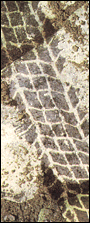 The
skill in tackling rock
conditions is to keep to the
high ground wherever possible in
order to avoid damage to the
diffs, transmission or
skidplates. The
skill in tackling rock
conditions is to keep to the
high ground wherever possible in
order to avoid damage to the
diffs, transmission or
skidplates.
Torque is more important than
power in climbing rock slopes,
thus first or second gear in low
range is best. Use light
throttle to prevent tyres
slipping.
|
|
|
|
MUD |
|
|
|
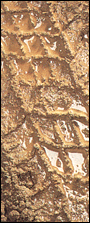 When
approaching soft muddy ground
build up speed in low ratio 2nd
or 3rd, try not to spin the
wheels by extreme acceleration.
Go too fast and you risk
bouncing and losing control, too
slow and you will lose momentum.
In severe mud the most difficult
conditions are where the ground
has rutted channels and axles
deep pits. Try to straddle the ruts
if they are too deep to
drive in – this will avoid
dragging the diffs through the
mud, which will reduce momentum
and probably leave your vehicle
stuck. Always try to maintain a
steady momentum. When driving in
ruts vary the accelerator and
move the steering wheel from
side to side – this allows the
lugs on the shoulders of the
tyres to grip and bite into the
sides of the ruts, let the
steering wheel find its own way.
Whenever possible check your
wheel arches to make sure they
are not clogged with mud, this
clogging will stop the tyres
from cleaning the mud from their
treads. When
approaching soft muddy ground
build up speed in low ratio 2nd
or 3rd, try not to spin the
wheels by extreme acceleration.
Go too fast and you risk
bouncing and losing control, too
slow and you will lose momentum.
In severe mud the most difficult
conditions are where the ground
has rutted channels and axles
deep pits. Try to straddle the ruts
if they are too deep to
drive in – this will avoid
dragging the diffs through the
mud, which will reduce momentum
and probably leave your vehicle
stuck. Always try to maintain a
steady momentum. When driving in
ruts vary the accelerator and
move the steering wheel from
side to side – this allows the
lugs on the shoulders of the
tyres to grip and bite into the
sides of the ruts, let the
steering wheel find its own way.
Whenever possible check your
wheel arches to make sure they
are not clogged with mud, this
clogging will stop the tyres
from cleaning the mud from their
treads.
|
|
|
|
|
|
|
SAND |
|
|
|
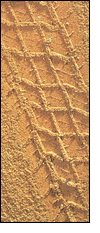 For
loose sand select high range
four wheel drive – this will
maintain speed, if however the
vehicle bogs down move in to low
range. For
loose sand select high range
four wheel drive – this will
maintain speed, if however the
vehicle bogs down move in to low
range.
Soft loose sand is traction
sapping and requires continual
momentum, often using full
throttle.
|
|
|
TRAVERSING
SLOPES |
|
|
|
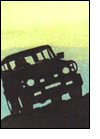 If
it is possible always find an
alternative route to avoid
traversing a slope. Always have
an escape route in mind. If it
is absolutely necessary to
traverse the face of a slope,
keep as low down as possible. If
the slope becomes dangerous turn
downhill and accelerate, this
will not only stop the vehicle
from rolling over, but will also
restore both steering capability
and traction to the tyres. If
it is possible always find an
alternative route to avoid
traversing a slope. Always have
an escape route in mind. If it
is absolutely necessary to
traverse the face of a slope,
keep as low down as possible. If
the slope becomes dangerous turn
downhill and accelerate, this
will not only stop the vehicle
from rolling over, but will also
restore both steering capability
and traction to the tyres.
|
|
|
|
WATER
CROSSING |
|
|
|
|
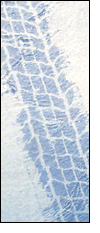 |
When
negotiating water it is important
that your electrics are
protected. Silicone based grease
on vulnerable items is a good
idea. It is absolutely vital
that your air intake will be
clear of the water. Ingress into
the engine is terminal and
expensive. Before tackling water
crossing it is critical to
survey the course first.
|
|
|
Consider:
-
The
river flow, fast flowing
means clean silt-free water.
Slow moving may mean soft
deep silt.
- Check
the depth of water and any
silt with a spade or
similar. Also check for
holes or large rocks which
may impede your progress.
-
Look
closely at the entry and
exit banks, bear in mind on
exit you will have little
momentum.
When
entering the water select low
2nd gear. Creating a bow wave
means the water in front of the
vehicle is deeper but a trough
is created behind the wave, ie.
In the engine bay. If you go too
fast the bow wave will break
over the bonnet losing trough
effect in the engine bay. When
clear of the water always drive
a short distance with the
footbrake lightly depressed to
restore braking efficiency.
Check your radiator to ensure
that it is clear of mud
and leaves, and of course check
for damage to your tyres,
because you will not have been
able to see potentially damaging
underwater obstacles. |
|
|
|
|
|
|
DESCENDING |
|
|
|
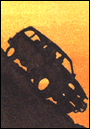 Look
down the hill from outside the
vehicle before thinking of
driving down. Go down only in
1st low. Do not try to change
gear as you risk missing a gear
and descending out of control in
neutral. Do not brake on steep
hills, allow the engine to do
the braking. Look
down the hill from outside the
vehicle before thinking of
driving down. Go down only in
1st low. Do not try to change
gear as you risk missing a gear
and descending out of control in
neutral. Do not brake on steep
hills, allow the engine to do
the braking.
If the vehicle should start to
slide blip the throttle to make
the wheels and tyres match the
speed of which you are
traveling. This brings back
control and steering, now back
off the throttle to try to slow
the vehicle down.
At the base of the hill be
careful not to dig the front
bumper in to the ground, select
a route where this cannot
happen.
|
|
|
|
DITCHES
AND RIDGES |
|
|
|
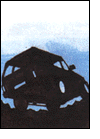 Many
can be easily crossed if
approached at the correct angle.
Approach the ditch diagonally,
putting one wheel in the ditch
at a time, allowing three wheels
to have tractive effort. Ensure
the steering wheel is straight
until you are across. Low ridges
should be crossed a similar way
to ditches, this is to ensure
the vehicle does not get stuck
through approach or exit angles
or by grounding. Many
can be easily crossed if
approached at the correct angle.
Approach the ditch diagonally,
putting one wheel in the ditch
at a time, allowing three wheels
to have tractive effort. Ensure
the steering wheel is straight
until you are across. Low ridges
should be crossed a similar way
to ditches, this is to ensure
the vehicle does not get stuck
through approach or exit angles
or by grounding.
|
|
|
|
ASCENDING |
|
|
|
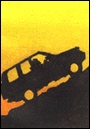 Always
drive up a hill or a steep bank
squarely, taking the straightest
most direct route to the top.
Check the route first to see if
there are any holes or bumps
which might at worst throw you
sideway and cause a rollover.
Do not change gear when
negotiating an obstacle, apart
from changing down on crest of a
hill to descend. If you try to
change gear when ascending
momentum will be lost. Always
drive up a hill or a steep bank
squarely, taking the straightest
most direct route to the top.
Check the route first to see if
there are any holes or bumps
which might at worst throw you
sideway and cause a rollover.
Do not change gear when
negotiating an obstacle, apart
from changing down on crest of a
hill to descend. If you try to
change gear when ascending
momentum will be lost.
Select 2nd or 3rd low, building
up enough momentum to carry you
to the top of the hill.
Finishing at walking pace at the
top. if you fail to make the
crest of a hill, depress the
footbrake and clutch
simultaneously select reverse
and take both feet off the
clutch and brakes simultaneously
and under engine braking return
to the base of the hill, do not
touch either pedal.
If your engine has stalled
depress the footbrake, the
vehicle is now held in gear and
on the footbrake. Depress the
clutch and select reverse, and
release the clutch pedal.
Quickly flip the ignition key
whilst taking your foot off the
brake, the weight of the vehicle
will ensure the engines starts
and the vehicle will come back
to the hill base under engine
braking.
|
|
|
|
|
|
|
|
|
|
|
|
|
|
|
|
Copyright
© 2013 FOUR WHEEL SUSPENSION PARTS SDN BHD,
Designed & Maintained by  |
|
|